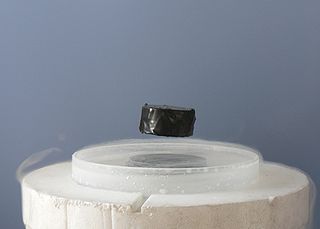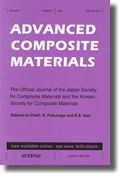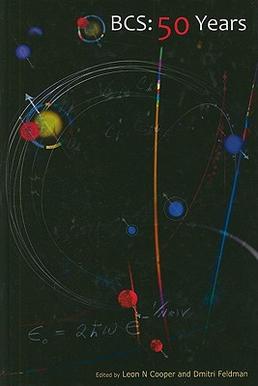
Superconductivity is a set of physical properties observed in certain materials where electrical resistance vanishes and magnetic flux fields are expelled from the material. Any material exhibiting these properties is a superconductor. Unlike an ordinary metallic conductor, whose resistance decreases gradually as its temperature is lowered, even down to near absolute zero, a superconductor has a characteristic critical temperature below which the resistance drops abruptly to zero. An electric current through a loop of superconducting wire can persist indefinitely with no power source.
Unconventional superconductors are materials that display superconductivity which does not conform to either the conventional BCS theory or Nikolay Bogolyubov's theory or its extensions.

High-temperature superconductors are defined as materials that behave as superconductors at temperatures above 77 K, the boiling point of liquid nitrogen. The adjective "high temperature" is only in respect to previously known superconductors, which function at even colder temperatures close to absolute zero. In absolute terms, these "high temperatures" are still far below ambient, and therefore require cooling. The first high-temperature superconductor was discovered in 1986, by IBM researchers Bednorz and Müller, who were awarded the Nobel Prize in Physics in 1987 "for their important break-through in the discovery of superconductivity in ceramic materials". Most high-Tc materials are type-II superconductors.
A room-temperature superconductor is a material that is capable of exhibiting superconductivity at operating temperatures above 0 °C, that is, temperatures that can be reached and easily maintained in an everyday environment. As of 2020, the material with the highest claimed superconducting temperature is an extremely pressurized carbonaceous sulfur hydride with a critical transition temperature of +15 °C at 267 GPa. On 22 September 2022, the original article reporting superconductivity in the carbonaceous sulfur hydride material was retracted by Nature journal editorial board due to a non standard, user-defined data analysis, calling into question the scientific validity of the claim.

Superconductivity is the phenomenon of certain materials exhibiting zero electrical resistance and the expulsion of magnetic fields below a characteristic temperature. The history of superconductivity began with Dutch physicist Heike Kamerlingh Onnes's discovery of superconductivity in mercury in 1911. Since then, many other superconducting materials have been discovered and the theory of superconductivity has been developed. These subjects remain active areas of study in the field of condensed matter physics.

Nature Materials is a peer-reviewed scientific journal published by Nature Publishing Group. It was launched in September 2002. Vincent Dusastre is the launching and current chief editor.
Ning Li was an American scientist known for her controversial anti-gravity research. In the 1990s, Li worked as a research scientist at the Center for Space Plasma and Aeronomic Research, University of Alabama in Huntsville. In 1999, she left the university to form a company, AC Gravity, LLC, to continue anti-gravity research.

Jorge Eduardo Hirsch is an Argentine American professor of physics at the University of California, San Diego. Hirsch received a PhD in physics from the University of Chicago in 1980 and completed his postdoctoral research at the Kavli Institute for Theoretical Physics at the University of California, Santa Barbara in 1983. He is known for inventing the h-index in 2005, an index for quantifying a scientist's publication productivity and the basis of several scholar indices.

The Journal of Electronic Materials is a monthly peer-reviewed scientific journal that publishes studies, research, developments, and applications of materials that produce electronics. The editor-in-chief is Shadi Shahedipour-Sandvik, SUNY Polytechnic Institute.The IEEE/TMS Journal of Electronic Materials (JEM) is jointly sponsored by the IEEE Electron Devices Society and The Minerals, Metals and Materials Society. It is published by Springer on behalf of IEEE and TMS.
CSA was a division of Cambridge Information Group and provider of online databases, based in Bethesda, Maryland before merging with ProQuest of Ann Arbor, Michigan in 2007. CSA hosted databases of abstracts and developed taxonomic indexing of scholarly articles. These databases were hosted on the CSA Illumina platform and were available alongside add-on products like CSA Illustrata. The company produced numerous bibliographic databases in different fields of the arts and humanities, natural and social sciences, and technology. Thus, coverage included materials science, environmental sciences and pollution management, biological sciences, aquatic sciences and fisheries, biotechnology, engineering, computer science, sociology, linguistics, and other areas.
Michael Tinkham was an American physicist. He was Rumford Professor of Physics and Gordon McKay Research Professor of Applied Physics at Harvard University. He is best known for his work on superconductivity.

Physics-Uspekhi is a peer-reviewed scientific journal. It is an English translation of the Russian journal of physics, Uspekhi Fizicheskikh Nauk which was established in 1918. The journal publishes long review papers which are intended to generalize and summarize previously published results, making them easier to use and to understand. The journal covers all topics of modern physics. The English version has existed since 1958, first under the name Soviet Physics Uspekhi and after 1993 as Physics-Uspekhi. The year 2008 marked the 90th birthday with a jubilee retrospective.

Advanced Composite Materials is a bimonthly peer-review scientific journal that was established in 1991. It is published by Taylor & Francis on behalf of the Japan Society for Composite Materials and the Korean Society for Composite Materials. The journal covers all scientific and technological aspects of composite materials and composite material structures, including physical, chemical, mechanical, and other properties of advanced composites as well as microscopic to macroscopic behavior studied both experimentally and theoretically. Novel fabrication techniques for composites and composite structural components are also included.

Scripta Materialia is a peer-reviewed scientific journal. It is the "letters" section of Acta Materialia and covers novel properties, or substantially improved properties of materials. Specific materials discussed are metals, ceramics and semiconductors at all length scales, and published research endeavors explore the functional or mechanical behavior of these materials. Articles tend to focus on the materials science and engineering aspects of discovery, characterization, development, structure, chemistry, theory, experiment, modeling, simulation, physics processes, synthesis, processing (production), mechanisms, and control.

BCS: 50 Years is a review volume edited by Leon Cooper, a 1972 Nobel Laureate in Physics, and Dmitri Feldman of Brown University, first published in 2010.

The B. Verkin Institute for Low Temperature Physics and Engineering is a research institute that conducts basic research in experimental and theoretical physics, mathematics, as well as in the field of applied physics. It was founded in 1960 by Borys Verkin, Oleksandr Galkin, Borys. Eselson and Ihor Dmytrenko. The first director was Borys Verkin.
Mohit Randeria is a US-based Indian condensed matter physicist and a professor of physics at Ohio State University. Known for his research on condensed matter theory and superconductivity, Randeria is an elected fellow of the American Physics Society. The Council of Scientific and Industrial Research, the apex agency of the Government of India for scientific research, awarded him the Shanti Swarup Bhatnagar Prize for Science and Technology, one of the highest Indian science awards, for his contributions to physical sciences in 2002. He was awarded the 2002 ICTP Prize of the International Center for Theoretical Physics, Trieste and the 2022 John Bardeen Prize.
Carbonaceous sulfur hydride is a purported room-temperature superconductor that was announced in October 2020. The material is claimed to have a maximal superconducting transition temperature of 15 °C (59 °F) at a pressure of 267 gigapascals (GPa), though the validity of the claim has faced criticism. In September 2022 the article was retracted by Nature journal editorial board due to a non standard, user-defined data analysis calling into question the scientific validity of the claim.

Anatolie S. Sidorenko is a doctor of physical and mathematical sciences and professor at the Technical University of Moldova. He specializes in condensed matter physics with the focus on electronic transport and magnetic properties of low dimensional systems – thin films and layered superconductors, design of superconducting devices and sensors. He made key contributions to investigation of novel superconducting materials and hybrid structures superconductor-ferromagnet, multiband and triplet superconductivity.











